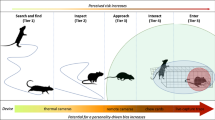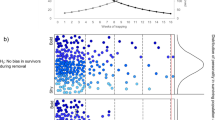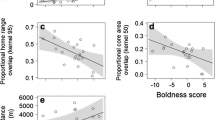Abstract
If bold animals are more likely to be trapped than shy animals, we take a biased sample of personalities—a problem for behavioural research. Such a bias is problematic, also, for population estimation using mark-recapture models that assume homogeneity in detection probabilities. In this study, we investigated whether differences in boldness result in differences in detection probability in a native Australian rodent, the grassland melomys (Melomys burtoni). During a mark-recapture study of this species, we used modified open field tests to assess the boldness (via emergence, and interaction with a novel object) of melomys trapped on the last night of four trapping nights in each of two trapping sessions. Despite melomys showing repeatable variation in these behavioural traits, neither boldness nor emergence latency had an effect on detection probability, and we found no evidence that detection probability varied between individuals. This result suggests that any neophobia is experienced and resolved in individuals of this species on a scale of minutes, rather than the hours across which traps are made available each night. Our work demonstrates that personality-caused sampling bias may not be inevitable, even in situations where animals are required to respond to novelty to be detected, such as in baited traps. Heterogeneity in personality does not inevitably lead to heterogeneity in detection probability.
Significance statement
Historically, passive traps were assumed a non-biased means of sampling animal populations. Increasingly behavioural ecologists suggest that personality traits, particularly individual boldness, may influence behaviour and, as a consequence, could result in sampling bias. Here, we present a comprehensive example of when animal personality has no effect on detection probability. Despite having distinct personalities, detection probabilities of a native Australian rodent, grassland melomys Melomys burtoni, were not influenced by whether they were ‘shy’ or ‘bold’. We provide evidence that heterogeneity in personality does not inevitably lead to heterogeneity in detection probability. Given that population estimation models typically assume homogeneity in detection probability between individuals, if this is a broad phenomenon, consistently similar results may improve our confidence in this assumption.



Similar content being viewed by others
Data availability
The datasets generated and analysed during the current study are available from the corresponding author on reasonable request.
References
Arakawa H, Cruz S, Deak T (2011) From models to mechanisms: odorant communication as a key determinant of social behavior in rodents during illness-associated states. Neurosci Biobehav Rev 35:1916–1928. https://doi.org/10.1016/j.neubiorev.2011.03.007
Begg R, Walsh B, Woerle F, King S (1983) Ecology of Melomys burtoni, the grassland Melomys (Rodentia: Muridae) at Cobourg Peninsula, N.T. Wildl Res 10:259–267
Bell AM, Hankison SJ, Laskowski KL (2009) The repeatability of behaviour: a meta-analysis. Anim Behav 77:771–783
Biro PA (2013) Are most samples of animals systematically biased? Consistent individual trait differences bias samples despite random sampling. Oecologia 171:339–345. https://doi.org/10.1007/s00442-012-2426-5
Biro PA, Dingemanse NJ (2009) Sampling bias resulting from animal personality. Trends Ecol Evol 24:66–67. https://doi.org/10.1016/j.tree.2008.11.001
Boyer N, Réale D, Marmet J, Pisanu B, Chapuis JL (2010) Personality, space use and tick load in an introduced population of Siberian chipmunks Tamias sibiricus. J Anim Ecol 79:538–547. https://doi.org/10.1111/j.1365-2656.2010.01659.x
Brown C, Braithwaite VA (2004) Size matters: a test of boldness in eight populations of the poeciliid Brachyraphis episcopi. Anim Behav 68:1325–1329. https://doi.org/10.1016/j.anbehav.2004.04.004
Carere C, Drent PJ, Privitera L, Koolhaas JM, Groothuis TGG (2005) Personalities in great tits, Parus major: stability and consistency. Anim Behav 70:795–805. https://doi.org/10.1016/j.anbehav.2005.01.003
Carothers AD (1973) The effects of unequal catchability on Jolly-Seber estimates. Biometrics 29:79. https://doi.org/10.2307/2529678
Carter AJ, Heinsohn R, Goldizen AW, Biro PA (2012) Boldness, trappability and sampling bias in wild lizards. Anim Behav 83:1051–1058. https://doi.org/10.1016/j.anbehav.2012.01.033
Carter AJ, Feeney WE, Marshall HH, Cowlishaw G, Heinsohn R (2013) Animal personality: what are behavioural ecologists measuring? Biol Rev 88:465–475. https://doi.org/10.1111/brv.12007
Cooper WE, Pyron RA, Garland T (2014) Island tameness: living on islands reduces flight initiation distance. Proc R Soc B 281:20133019. https://doi.org/10.1098/rspb.2013.3019
Cubaynes S, Pradel R, Choquet R et al (2010) Importance of accounting for detection heterogeneity when estimating abundance: the case of French wolves. Conserv Biol 24:621–626. https://doi.org/10.1111/j.1523-1739.2009.01431.x
Dall SRX, Houston AI, McNamara JM (2004) The behavioural ecology of personality: consistent individual differences from an adaptive perspective. Ecol Lett 7:734–739. https://doi.org/10.1111/j.1461-0248.2004.00618.x
Dielenberg RA, McGregor IS (2001) Defensive behavior in rats towards predatory odors: a review. Neurosci Biobehav Rev 25:597–609. https://doi.org/10.1016/S0149-7634(01)00044-6
Dorazio RM, Royle JA (2003) Mixture models for estimating the size of a closed population when capture rates vary among individuals. Biometrics 59:351–364. https://doi.org/10.1111/1541-0420.00042
Dyer BC, Clarke AR, Fuller SJ (2011) Population dynamics, diet and pest status of the grassland melomys (Melomys burtoni) in northern Queensland sugarcane crops. Wildl Res 38:330. https://doi.org/10.1071/WR10171
Garamszegi LZ, Eens M, Török J (2009) Behavioural syndromes and trappability in free-living collared flycatchers, Ficedula albicollis. Anim Behav 77:803–812. https://doi.org/10.1016/j.anbehav.2008.12.012
Gilbert RO (1973) Approximations of the bias in the Jolly-Seber capture-recapture model. Biometrics 29:501. https://doi.org/10.2307/2529173
Gould TD, Dao DT, Kovacsics CE (2009) The open field test. In: Gould TD (ed) Mood and anxiety related phenotypes in mice. Humana Press, Totowa, NJ, pp 1–20
Hwang W-H, Huggins R (2005) An examination of the effect of heterogeneity on the estimation of population size using capture-recapture data. Biometrika 92:229–233. https://doi.org/10.1093/biomet/92.1.229
Jolly GM (1965) Explicit estimates from capture-recapture data with both death and immigration-stochastic model. Biometrika 52:225–247
Kemper CM, Kitchener DJ, Humphreys WF, How RA, Bradley AJ, Schmitt LH (1987) The demography and physiology of Melomys sp. (Rodentia: Muridae) in the Mitchell Plateau area, Kimberley, Western Australia. J Zool 212:533–562. https://doi.org/10.1111/j.1469-7998.1987.tb02923.x
King CM, Davis SA, Purdey D, Lawrence B (2003) Capture probability and heterogeneity of trap response in stoats (Mustela erminea). Wildl Res 30:611. https://doi.org/10.1071/WR02091
Koski SE (2014) Broader horizons for animal personality research. Front Ecol Evol 2:1–6. https://doi.org/10.3389/fevo.2014.00070
Le Cœur C, Thibault M, Pisanu B, Thibault S, Chapuis JL, Baudry E (2015) Temporally fluctuating selection on a personality trait in a wild rodent population. Behav Ecol 26:1285–1291. https://doi.org/10.1093/beheco/arv074
Link WA (2003) Nonidentifiability of population size from capture-recapture data with heterogeneous detection probabilities. Biometrics 59:1123–1130. https://doi.org/10.1111/j.0006-341X.2003.00129.x
López P, Hawlena D, Polo V, Amo L, Martín J (2005) Sources of individual shy–bold variations in antipredator behaviour of male Iberian rock lizards. Anim Behav 69:1–9. https://doi.org/10.1016/j.anbehav.2004.05.010
Madsen T, Shine R (1996) Seasonal migration of predators and prey-a study of pythons and rats in tropical Australia. Ecology 77:149–156. https://doi.org/10.2307/2265663
McGregor IS, Schrama L, Ambermoon P, Dielenberg RA (2002) Not all ‘predator odours’ are equal: cat odour but not 2, 4, 5 trimethylthiazoline (TMT; fox odour) elicits specific defensive behaviours in rats. Behav Brain Res 129:1–16
Michelangeli M, Wong BBM, Chapple DG (2016) It’s a trap: sampling bias due to animal personality is not always inevitable. Behav Ecol 27:62–67. https://doi.org/10.1093/beheco/arv123
Montiglio P-O, Garant D, Thomas D, Réale D (2010) Individual variation in temporal activity patterns in open-field tests. Anim Behav 80:905–912. https://doi.org/10.1016/j.anbehav.2010.08.014
Montiglio P-O, Garant D, Pelletier F, Réale D (2012) Personality differences are related to long-term stress reactivity in a population of wild eastern chipmunks, Tamias striatus. Anim Behav 84:1071–1079. https://doi.org/10.1016/j.anbehav.2012.08.010
Moseby KE, Carthey AJR, Schroeder T (2015) The influence of predators and prey naivety on reintroduction success: current and future directions. In: Armstrong DP, Hayward MW, Moro D, Seddon PJ (eds) Advances in reintroduction biology of Australia and New Zealand Fauna. CSRIO Publishing, Collingwood, Victoria, pp 29–42
Niemelä PT, Dingemanse NJ (2018) On the usage of single measurements in behavioural ecology research on individual differences. Anim Behav 145:99–105. https://doi.org/10.1016/j.anbehav.2018.09.012
Paull DJ, Claridge AW, Barry SC (2011) There’s no accounting for taste: bait attractants and infrared digital cameras for detecting small to medium ground-dwelling mammals. Wildl Res 38:188. https://doi.org/10.1071/WR10203
Pawluski JL, Brummelte S, Barha CK, Crozier TM, Galea LA (2009) Effects of steroid hormones on neurogenesis in the hippocampus of the adult female rodent during the estrous cycle, pregnancy, lactation and aging. Front Neuroendocrinol 30:343–357. https://doi.org/10.1016/j.yfrne.2009.03.007
Perals D, Griffin AS, Bartomeus I, Sol D (2017) Revisiting the open-field test: what does it really tell us about animal personality? Anim Behav 123:69–79. https://doi.org/10.1016/j.anbehav.2016.10.006
R Core Team (2019) R: a language and environment for statistical computing. R Foundation for statistical computing, Vienna, http://www.R-project.org
Réale D, Gallant BY, Leblanc M, Festa-Bianchet M (2000) Consistency of temperament in bighorn ewes and correlates with behaviour and life history. Anim Behav 60:589–597. https://doi.org/10.1006/anbe.2000.1530
Réale D, Reader SM, Sol D, McDougall PT, Dingemanse NJ (2007) Integrating animal temperament within ecology and evolution. Biol Rev 82:291–318. https://doi.org/10.1111/j.1469-185X.2007.00010.x
Rodl T, Berger S, Michael Romero L, Wikelski M (2007) Tameness and stress physiology in a predator-naive island species confronted with novel predation threat. Proc R Soc Lond B 274:577–582. https://doi.org/10.1098/rspb.2006.3755
Royle JA, Dorazio RM (2008) Hierarchical modeling and inference in ecology: the analysis of data from populations, metapopulations and communities. Academic Press, San Diego
Seber GAF (1970) The effects of trap response on tag recapture estimates. Biometrics 26:13. https://doi.org/10.2307/2529040
Shine R, Brown GP (2008) Adapting to the unpredictable: reproductive biology of vertebrates in the Australian wet-dry tropics. Philos Trans R Soc B 363:363–373. https://doi.org/10.1098/rstb.2007.2144
Sih A, Bell A, Johnson JC (2004) Behavioral syndromes: an ecological and evolutionary overview. Trends Ecol Evol 19:372–378. https://doi.org/10.1016/j.tree.2004.04.009
Sih A, Cote J, Evans M, Fogarty S, Pruitt J (2012) Ecological implications of behavioural syndromes. Ecol Lett 15:278–289. https://doi.org/10.1111/j.1461-0248.2011.01731.x
Smith BR, Blumstein DT (2008) Fitness consequences of personality: a meta-analysis. Behav Ecol 19:448–455. https://doi.org/10.1093/beheco/arm144
Stoffel MA, Nakagawa S, Schielzeth H (2017) rptR: repeatability estimation and variance decomposition by generalized linear mixed-effects models. Methods Ecol Evol 8:1639–1644
Stuber EF, Araya-Ajoy YG, Mathot KJ, Mutzel A, Nicolaus M, Wijmenga JJ, Mueller JC, Dingemanse NJ (2013) Slow explorers take less risk: a problem of sampling bias in ecological studies. Behav Ecol 24:1092–1098. https://doi.org/10.1093/beheco/art035
Sunnucks P (1998) Avoidance of novel objects by rabbits (Oryctolagus cuniculus L.). Wildl Res 25:273. https://doi.org/10.1071/WR97038
Tasker E, Dickman C (2001) A review of Elliott trapping methods for small mammals in Australia. Aust Mammal 23:77. https://doi.org/10.1071/AM01077
Taylor JA, Tulloch D (1985) Rainfall in the wet-dry tropics: extreme events at Darwin and similarities between years during the period 1870–1983 inclusive. Austral Ecol 10:281–295. https://doi.org/10.1111/j.1442-9993.1985.tb00890.x
Terborgh J, Lopez L, Nunez P, Rao M, Shahabuddin G, Orihuela G, Riveros M, Ascanio R, Adler GH, Lambert TD, Balbas L (2001) Ecological meltdown in predator-free forest fragments. Science 294:1923–1926
Vanden Broecke B, Borremans B, Mariën J, Makundi RH, Massawe AW, Leirs H, Hughes NK (2018) Does exploratory behavior or activity in a wild mouse explain susceptibility to virus infection? Curr Zool 64:585–592. https://doi.org/10.1093/cz/zox053
Walsh RN, Cummins RA (1976) The open-field test: a critical review. Psychol Bull 83:482–504
Ward-Fear G, Rangers B, Pearson D, Bruton M, Shine R (2019) Sharper eyes see shyer lizards: collaboration with indigenous peoples can alter the outcomes of conservation research. Conserv Lett (published online, https://doi.org/10.1111/conl.12643)
Wegge P, Pokheral CP, Jnawali SR (2004) Effects of trapping effort and trap shyness on estimates of tiger abundance from camera trap studies. Anim Conserv 7:251–256. https://doi.org/10.1017/S1367943004001441
Wilson DS, Coleman K, Clark AB, Biederman L (1993) Shy-bold continuum in pumpkinseed sunfish (Lepomis gibbosus): an ecological study of a psychological trait. J Comp Psychol 107:250–260. https://doi.org/10.1037//0735-7036.107.3.250
Wolf M, Weissing FJ (2012) Animal personalities: consequences for ecology and evolution. Trends Ecol Evol 27:452–461. https://doi.org/10.1016/j.tree.2012.05.001
Acknowledgments
Thanks to Kenbi Traditional Owners (Raelene and Zoe Singh) for land access permission and Kenbi Rangers for assistance in the field. Special thanks to Kenbi Rangers John Mango Moreen and Rex Edmunds for continued field assistance throughout this project. Thanks to Kenbi Ranger Co-ordinator Steven Brown for logistical support in the field. Thanks to Adam Smart for assistance in the field. We thank two anonymous reviewers for constructive feedback that greatly improved the manuscript.
Funding
This research was funded by an Australian Research Council Linkage Grant (JKW and BP LP150100722). In kind support was provided by the Northern Territory Government Department of Environment and Natural Resources, Flora and Fauna Division (via GRG). CJJ was supported by an Australian Postgraduate Award and the Holsworth Wildlife Research Endowment.
Author information
Authors and Affiliations
Corresponding author
Ethics declarations
Conflict of interest
The authors declare that they have no conflicts of interest.
Ethical approval
All applicable international, national and/or institutional guidelines for the use of animals were followed. We obtained permission to access Indian Island and to trap melomys from Indigenous Traditional Owners as part of on-going monitoring of a northern quoll population on the island (Permit to enter & remain on Aboriginal land or sea adjoining Aboriginal land (Research) from Northern Land Council, NT). We obtained permits allowing us to trap melomys from the Parks and Wildlife Commission of the Northern Territory (Permit to Undertake Scientific Research on Wildlife). The University of Melbourne Animal Ethics Committee approved the experimental design (ID number: 1814518).
Additional information
Communicated by A. G. Ophir
Publisher’s note
Springer Nature remains neutral with regard to jurisdictional claims in published maps and institutional affiliations.
Electronic supplementary material
ESM 1
(DOCX 24 kb)
Rights and permissions
About this article
Cite this article
Jolly, C.J., Webb, J.K., Gillespie, G.R. et al. Bias averted: personality may not influence trappability. Behav Ecol Sociobiol 73, 129 (2019). https://doi.org/10.1007/s00265-019-2742-4
Received:
Revised:
Accepted:
Published:
DOI: https://doi.org/10.1007/s00265-019-2742-4




